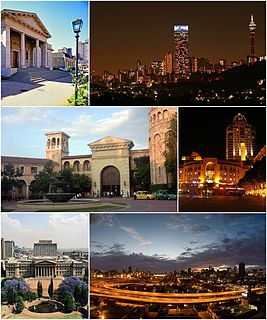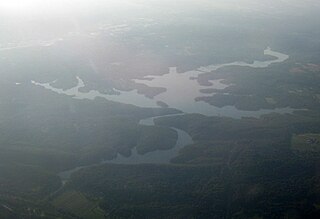| Donald Mackay Park | |
|---|---|
 Donald Mackay Park in Berea, South Africa |
Donald Mackay Park is a municipal park in the Berea district of Johannesburg, South Africa. It is located above the reservoir.
| Donald Mackay Park | |
|---|---|
 Donald Mackay Park in Berea, South Africa |
Donald Mackay Park is a municipal park in the Berea district of Johannesburg, South Africa. It is located above the reservoir.
Donald Mackay Park was built in 1896. The foundation stone of the reservoir was laid by Mrs. Von Brandis, wife of the first magistrate and Mining Commissioner of Johannesburg. The reservoir was designed to hold 227 million liters of water [1] to combat water shortages. The reservoir continues to function. [2] [3] [4]
The park adjacent to the reservoir was formerly known as ‘Andrew’s Reserve’ and ‘Waterworks Reservoir’. [5] Donald Mackay Park was given its current name on January 31, 1939, in honour of Donald William Mackay, mayor of Johannesburg from 1936–37.
Both the reservoir and the park are owned by the City.
Although it is not officially recognized as a heritage site, Donald Mackay Park is historically and culturally significant for several reasons:

Soweto is a township of the City of Johannesburg Metropolitan Municipality in Gauteng, South Africa, bordering the city's mining belt in the south. Its name is an English syllabic abbreviation for South Western Townships. Formerly a separate municipality, it is now incorporated in the City of Johannesburg Metropolitan Municipality, Suburbs of Johannesburg.

Johannesburg, informally known as Jozi or Joburg, is the largest city in South Africa and one of the 50 largest urban areas in the world. It is the provincial capital and largest city of Gauteng, which is the wealthiest province in South Africa. Johannesburg is the seat of the Constitutional Court. The city is located in the mineral-rich Witwatersrand range of hills and is the centre of large-scale gold and diamond trade.

Mackay is a city and its centre suburb in the Mackay Region on the eastern or Coral Sea coast of Queensland, Australia. It is located about 970 kilometres (603 mi) north of Brisbane, on the Pioneer River. Mackay is nicknamed the sugar capital of Australia because its region produces more than a third of Australia's sugar. At June 2018 Mackay had a population of 80,148, having decreased slightly at an average annual rate of -0.32% year-on-year over the preceding five years.

The Chennai Municipal Corporation, is the civic body that governs the city of Chennai, India. Inaugurated on 29 September 1688, under a Royal Charter issued by King James II on 30 December 1687 as the Corporation of Madras, it is the oldest municipal body of the Commonwealth of Nations outside Great Britain. It is headed by a mayor, who presides over 200 councillors each of whom represents one of the 200 wards of the city. It is the second oldest city civic body in the world after the City of London.

MacRitchie Reservoir is Singapore's oldest reservoir. The reservoir was completed in 1868 by impounding water from an earth embankment, and was then known as the Impounding Reservoir or Thomson Reservoir.

The City of Johannesburg Metropolitan Municipality is a metropolitan municipality that manages the local governance of Johannesburg, South Africa. It is divided into several branches and departments in order to expedite services for the city.

Stretching up to 125 miles away from the city, New York City's water supply system is one of the most extensive municipal water systems in the world. With three major water systems, New York City's water supply system is a combination of aqueducts, reservoirs, and tunnels that meets the daily needs of New York City's more than eight million residents and its many visitors.

The McMillan Reservoir is a reservoir in Washington, D.C. that supplies the majority of the city's municipal water. It was originally called the Howard University Reservoir or the Washington City Reservoir, and was completed in 1902 by the U.S. Army Corps of Engineers. The reservoir was built on the site of Smith Spring, one of the springs previously used for drinking water. Washington's earliest residents relied on natural springs but this came to be inadequate as the city's population grew. In 1850, Congress determined that the Potomac River should be the city's principal source of water.

Ridgewood Reservoir is a decommissioned 19th century reservoir that sits on the Brooklyn–Queens border in New York City, within what is now Highland Park. The reservoir itself is actually on the Queens side of the border in the neighborhood of Glendale. The reservoir and park are bounded on the north by the Jackie Robinson Parkway, on the south by Highland Boulevard, on the west by the backyards of homes on Bulwer Place and on the east by Cypress Hills National Cemetery.

The Loch Raven Reservoir is a reservoir that provides drinking water for the City of Baltimore and most of surrounding suburban Baltimore County, Maryland. It is part of a regional public water supply system operated by Baltimore City on behalf of and in cooperation with Baltimore County. Additional jurisdictions of northern Anne Arundel County also benefit and are tied into the system and the matching sewage / waste water system and run by and responsible to the Baltimore City Department of Public Works with all of the several dams, reservoirs, filtration plants and connecting pipes and tunnels. It was first begun in the mid-19th century, after the City took over the former private Baltimore Water Company, which when established in 1792 was the first water supply company in America. Over the rest of the 1800 and into the 20th century, the City envisioned, designed, built, enlarged, renovated and repaired the public water supply system and gradually over the decades added additional dams, lakes/reservoirs, pumping & filtration stations and the needed pipes and tunnels throughout central Maryland. Over the last 170 years, the city's architects, designers, draftsmen, engineers, construction superintendents and thousands of plain ordinary foremen and hired laboring workers/citizens figured out how to use, master and exploit the flowing water resources of several surrounding streams, creeks and rivers of central Maryland harnessing the natural flows to enlarge the capacity of gallons stored and equitably distributed for the growing population now into two millions of residents. Jones Falls, the upper Patapsco River, Gwynns Falls, Herring Run and the Gunpowder River were dammed, rerouted, excavated, pumped, pipes laid, tunnels dug and plants/stations constructed to feed the voracious thirsty appetite of Baltimoreans and its industries/commercial/business activities, including fire control. In later decades of the 20th century, increasing concerns and public demands required greater stricter measures for cleaner water and protection from contamination either intended or unintended.

The Hackensack Water Company Complex is a set of historic buildings in Weehawken, New Jersey, registered in the U.S. National Register of Historic Places. The Hackensack Water Company, a predecessor of Suez North America, developed water supply and storage in northeastern New Jersey from the 1870s to the 1970s, initially to provide service to the city of Hackensack and the towns of North Hudson. Originally its headquarters and major facilities were located at Hackensack, in Bergen County. Under Robert W. de Forest, who ran the Hackensack Water Company for 46 years beginning in 1881, the company constructed new facilities and moved its headquarters to Weehawken in Hudson County, setting up offices in a brick water tower, part of the present complex.
Aytaç Durak is a Turkish politician, and has been the mayor of Adana since 1984, excluding one term (1989–1994). He is the longest serving locally elected city mayor in Turkey, currently at his 5th term. Adding his 17 years as a municipal councillor, he will have served the municipality of Adana for 42 years by the end of this term. He was the president of the Municipalities Union of Turkey for 17 years and the Çukurova Municipalities Union for 12 years.
Moti Jheel is a lake and drinking water reservoir in the Benajhabar area of Kanpur, which together with its adjoining gardens and children's park is an important tourist attraction. Built during the British Raj, today along with Kamala Retreat and Moti Park, it is an important recreational place in the bustling industrial city of Kanpur, once known as the "Manchester of the East".

The Paddington Reservoir is a heritage-listed public park located at 255a Oxford Street in the inner eastern Sydney suburb of Paddington in the City of Sydney local government area of New South Wales, Australia. It was designed by Edward Bell and built from 1864 to 1866 and operated as a water reservoir which accepted water from the Botany Swamps pumping station for supply to parts of Sydney between 1866 and 1899. In the twentieth century the site variously functioned as a service station and storage and mechanical workshop site. In 2006 it was converted into a sunken garden and park. It is also known as Walter Read Reserve; Paddington Reservoir Gardens; Reservoir Gardens. The property is owned by City of Sydney. It was added to the New South Wales State Heritage Register on 2 April 1999.
The following is a timeline of the history of the city of Johannesburg, in the Gauteng province of South Africa.

Mackay Town Hall is a heritage-listed former town hall at 63 Sydney Street, Mackay, Mackay Region, Queensland, Australia. It is the second town hall to be built on this site. It was designed by Arthur Rigby built in 1912 by Charles Porter for the Mackay Town Council. It was added to the Queensland Heritage Register on 29 May 1998.

The Yeoville Water Tower is located in Harley and Percy Streets, Yeoville, near the fountain of Doornfontein; it was built in 1914 by the Sivewright's Johannesburg Waterworks, Estate and Exploration company. It was constructed with a reservoir to supply piped water to Johannesburg.

The Centennial Park Reservoir or WS001 is a heritage-listed reservoir at 3R Oxford Street, Centennial Park, City of Randwick, New South Wales, Australia. It was designed and built by NSW Public Works Department from 1896 to 1898. The property is owned by Sydney Water, an agency of the Government of New South Wales. It was added to the New South Wales State Heritage Register on 18 November 1999.